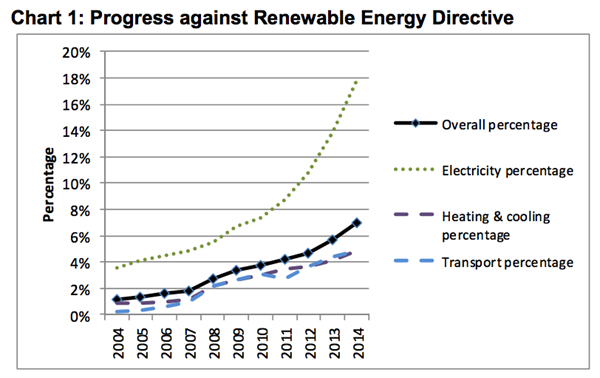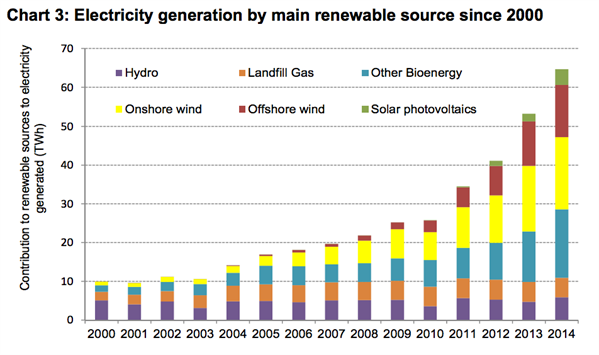
UK meets interim renewable energy target, says DECC report
Simon Evans
06.25.15Simon Evans
25.06.2015 | 11:40amContrary to recent press reports, the UK met its interim renewable energy target for 2013/14, according to a report issued earlier this morning.
The news came as ministers for the Department for Energy and Climate Change (DECC) defended their approach in parliament, fending off questions about the decision to end support for onshore wind early despite it being the cheapest form of renewable power.
The UK remains well short of its target under the EU Renewable Energy Directive. The UK must source 15% of its energy for heat, transport and power from renewable sources by 2020. As of 2013, the UK was further behind its 2020 goal than any other EU member state.
Renewable progress
Last week, the Guardian reported on progress towards the EU 2020 renewables goals under the headline, “UK misses interim renewable energy target”. The headline was later amended. ENDS Report also said the UK had missed its target. Business Green and other publications said a European Commission report found the UK was at risk of missing its 2020 goal.
Today, a new update from DECC says the UK actually surpassed its interim target for 2013/14. Renewables supplied 7.0% of UK energy needs in 2014, it says, up from the previously reported figure for 2013 of 5.1%. That means the UK got 6.3% of its energy from renewables averaged over 2013/14, easily passing its interim goal of 5.4%.
Share of UK energy for heat, transport and power supplied by renewables. Source: DECC
The fastest growth in 2014 was in renewable electricity, which was up 11,377 gigawatt hours (GWh) (21%) on 2013’s output to 64,654GWh, according to DECC figures. Renewables generated nearly a fifth of all UK electricity needs in 2014.
Biomass power was the largest contributor to the increase in 2014, as the Drax plant in Yorkshire converted additional units from coal to wood pellets. Drax says this conversion generates large greenhouse gas benefits. A DECC-funded research project is investigating claims that biomass could be worse for the climate than coal.
There were also large increases in 2014 for solar, which more than doubled to 4,050GWh. This rapid growth has plummeted since 1 April, after access to the Renewables Obligation (RO) subsidy scheme was closed to solar farms. Installation rates fell from last year’s average of 210 megawatts (MW) per month to 43MW in April and 38MW in May.
Offshore wind output grew by 17% and onshore by 10%, taking combined output to 32,016GWh or around half of total renewable power generation. Last week, the government announced it would also close the RO early to onshore windfarms, potentially putting the brakes on further expansion.
Renewable electricity generation by source. Other bioenergy (blue) is largely biomass power generated at the Drax coal plant in Yorkshire. Source: DECC.
Renewables supplied 4.9% of total heat demand in 2014, up 0.7 percentage points on 2013. Domestic burning of wood for heat is the largest contributor to renewable heat use, making up 94% of the total. Of this, only a very small proportion (4.5%) is supported by the government’s renewable heat incentive subsidy (RHI) scheme.
Future funding for the RHI could be at risk as the government seeks to find £13bn of savings in its emergency budget on 8 July, from non-protected departments including DECC. Carbon Brief analysis found the RHI was one of the few areas of discretionary DECC spending, with the lion’s share going towards the costs of dealing with the UK’s nuclear waste and coal mining legacies.
Renewables supplied 4.8% of total transport energy in 2014, up 0.4 percentage points. The UK lacks a policy framework to progress beyond this level, which was mandated by the 2007 Renewable Transport Fuels Obligation.
Official 2014 figures on progress towards the 2020 EU renewables target will be published by the EU statistical agency Eurostat in 2016.
2020 goal
The UK remains at serious risk of missing its 2020 target, according to the European Commission. A proposal expected later today to part-privatise the government’s Green Investment Bank, which has supported windfarms and other low-carbon schemes to the tune of £2bn, would further reduce the UK’s ability to support renewables, according to the Liberal Democrats.
This and other recent policy changes put further strong growth in renewable electricity in doubt. On Tuesday, Miguel Arias Cañete, EU commissioner for climate and energy, criticised UK onshore wind subsidy changes, saying the move would make it harder to meet the 2020 renewables target.
Main image: Clatteringshaws Loch reservoir in Galloway Forest Park damming the Black Water of Dee to feed Glenlee hydro Power Station.
-
Contrary to recent press reports, the UK met its interim renewable energy target for 2013/14



